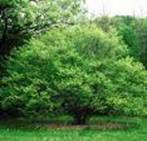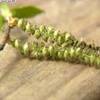| Kingdom | Plantae |
| Division | Magnoliophyta |
| Class | Magnoliopsida |
| Order | Fagales |
| Family | Betulaceae |
| Genus | Carpinus |
| Species | C. caroliniana |
| Binomial name | Carpinus caroliniana |
Other Common Names:
The other common names for the ironwood tree are Musclewood, Bluebeech, Waterbeech, Lechillo and American hornbeam.
History
American Hornbeam, usually called Ironwood in North Carolina, is a fairly common understory tree found mostly along streambanks. Species include the eastern, or American, hop hornbeam (Ostrya virginiana), a small tree of northern Iran (Parrotia persica), and Ceylon ironwood (Mesua ferrea).

Description
Ironwood is a small, nearly shrubby tree reaching up to 25 feet tall with a rounded crown and a twisted trunk. The leaves are alternate, simple, elliptical to ovate, 3 to 5 inches long, pinnately veined, tip acuminate, doubly serrate margin; waxy, smooth green above, paler below. Flowers are monoecious; males a slender, yellow-green hanging catkin, 1 to 2 inches long; female catkins yellow-green and fuzzy appearing from new branch tips, 1/2 to 3/4 inch long, both appearing in mid to late spring.



Range
Ironwood ranges throughout most of the eastern United States. American hornbeam is native to most of the eastern United States and extends into Canada in southwest Quebec and southeast Ontario. Its western limit is just beyond the Mississippi River from north-central Minnesota to the Missouri River, where it ranges south-westward into much of the Ozark and Ouachita Mountains and eastern Texas. It grows throughout much of the South but is absent from the Mississippi River bottom land south of Missouri, the lowermost Gulf Coastal Plain, and the southern two-thirds of Florida. Northward along the east coast, it is not found in the New Jersey pine barrens, much of Long Island, Cape Cod, northern and eastern Maine, and the White and Adirondack Mountains. It is found in central and southern Mexico, Guatemala, and western Honduras.
Habitat
A frequent understory tree in both forested uplands and forested wetlands; seldom found in inundated situations, but commonly grows in saturated forested wetlands. Often grows in association with overstory trees such as red maple, sweet gum,sycamore,and black gum; other understory trees that it may be associated with are flowering dogwood, American holly and red bay.
Cultivation
Best growth and development of American hornbeam occurs on rich, wet-mesic sites, but it is not restricted to such sites and can tolerate a wide variety of conditions. Habitat requirements and tolerances of the species are similar across its range. Seeds are best sown as soon as it is ripe in a cold frame, it normally germinates in spring. The germination rate is variable but usually good.'Green' seed, harvested when the embryo has fully formed but before the outer coat has dried, sown immediately in a cold frame germinates very well. Stored seed requires stratification, 3 months warm then 5 months cold usually works well but germination can take 18 months. When they are large enough to handle, prick the seedlings out into individual pots and grow them on in the cold frame for their first winter. Plant them out into their permanent positions in late spring or early summer, after the last expected frosts.
Flowering Season
Plants are monoecious. Flowers are borne in catkins; the males growing l l/2 inches long, the females growing about 1 inch long, with large, conspicuous 3-lobed bracts. Flowering occurs between March and May in the Southeast and during April through May in the North.
Pests and Diseases
Insect and disease damage is not a serious problem with American hornbeam. The species is resistant to frost damage; its succulent foliage can withstand temperatures as low as -8.5° C . The tree is very windfirm. Recreational use in forested campgrounds disposes it to increased disease infection, insect infestation and decline; it is the tree least capable of withstanding such use of the 22 hardwood species evaluated .American hornbeam is susceptible to fire. Wildfires severe enough to kill the hardwood component of white oak stands in Rhode Island eliminated American hornbeam. Normally, the species made up 6 percent of the understory stems. However, neither a crown fire nor a ground fire affected the status of American hornbeam in the ninth year after burning a loblolly pine stand in North Carolina.
Parts Used


The roots, leaves and the bark are the most commonly used parts of the tree for its commercial and medicinal applications.
Medicinal Applications

• Leaves and roots are used as a medicine.
• Inner bark is used as an emetic and purgative.
• The bark is astringent, blood tonic and haemostatic.
• A decoction of the bark is used to bathe sore muscles.
• An infusion of the bark can be held in the mouth to relieve the pain of toothache.
• An infusion of the heartwood has been used in the treatment of lung haemorrhages, coughs and colds, catarrh and kidney problems.
• It is also used as an herbal steam bath in the treatment of rheumatism.
Commercial Applications


• It is used as a patio tree, street tree, specimen, naturalizing.
• Any of numerous trees and shrubs, found worldwide, that have exceptionally tough or hard wood useful for timber, fence posts, and tool handles.
• Trunks are used for firewood, utensils, fenceposts, carvings and charcoal.
• Seed, leached and ground for use as food.
• The wood of American hornbeam is not important in commerce because the tree is too small, but it's tough, dense, and close-grained wood is used for tool handles, levers, wedges, and mallets.

In myths and legends from around the world, trees like ironwood appear as ladders between worlds, as sources of life and wisdom, and as the physical forms of supernatural beings. With its roots buried deep in the earth, its trunk above ground and its branches stretching toward the sky, a tree serves as a symbolic, living link between this world and those of supernatural beings. It is believed to have iron roots where the spirits of the dead lived in this tree. Some myths tell us that this is an immortal tree where it has the ability to live forever.